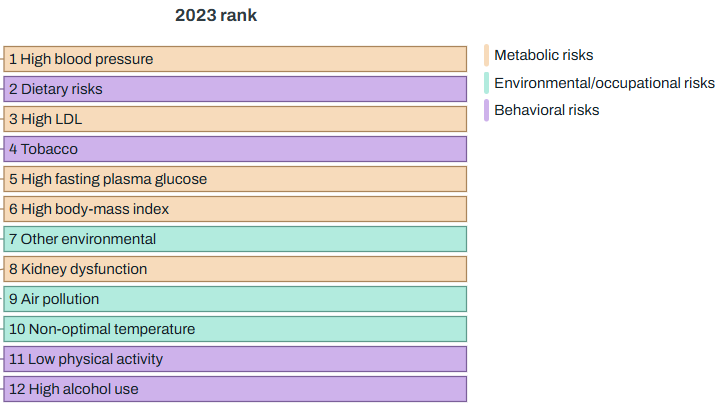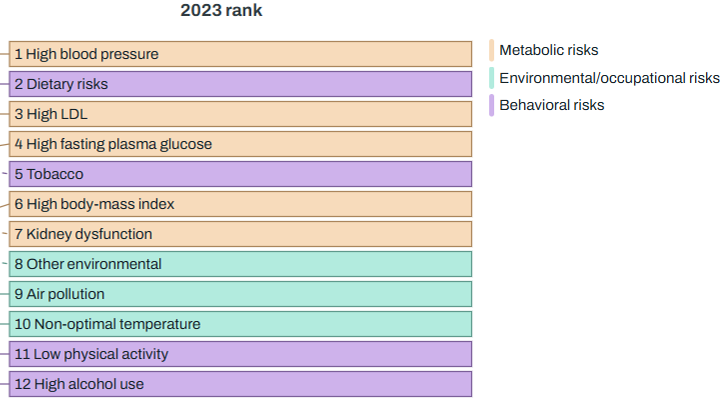Published: November 2025
Cardiovascular disease (CVD) is a general term for conditions affecting the heart or blood vessels. CVD is one of the main causes of death and disability in the UK, but it can often largely be prevented by leading a healthy lifestyle. In Yorkshire and the Humber region, CVD is the second highest contributing cause to Disability-Adjusted Life Years (DALYs), as well as the second highest cause of death after neoplasms. Regionally, 73% of CVD-related DALYs and 74% of CVD-related deaths are attributable to modifiable risk factors.
Headlines
- Every month, around 300 Wakefield residents are newly diagnosed with CVD.
- CVD is more prevalent and causes higher hospital admissions and mortality among the following groups in Wakefield:
- Males
- People in older age brackets
- Those living in the most deprived areas
- Coronary Heart Disease and Atrial Fibrillation are the most prevalent cardiovascular diseases in Wakefield.
- According to OHID Fingertips – Public Health Profiles, and compared to England national levels, Wakefield District has:
- Worse outcomes for many CVD risk factors
- Higher prevalence of Coronary Heart Disease, Atrial Fibrillation, Stroke, Diabetes and Hypertension
- Higher rates of CVD mortality for all ages, those under 75 and those under 75 where death is considered preventable
- Hospital admission rates for all CVD (all admissions and emergency) are lower for Wakefield residents than both national (England) and regional (Yorkshire & Humber) levels.
- Hospital admission rates for CVD (all admissions) are significantly lower among Wakefield residents of Mixed and Black ethnicities, and emergency admissions are significantly lower among Wakefield residents of Black ethnicities compared to the district average.
- The CVD conditions with the highest mortality rates in Wakefield are Coronary Heart Disease, Cerebrovascular Disease (including Stroke) and Other Heart Disease (including Heart Failure).
- Since 2000, the district average mortality rate for CVD across Wakefield has fallen by 53% and the under-75 rate for mortality considered preventable has decreased by 58%. However, these longer term decreasing trends have slowed and plateaued since 2015.
What is CVD?
There are many different types of CVD, some of the main types are: Cardiovascular disease includes conditions that narrow or block blood vessels (coronary heart disease). This can lead to a heart attack, angina and some strokes. Heart disease also covers conditions that affect your heart’s muscle, valves or cause abnormal rhythms (arrhythmias).
Types of CVD
According to the Global Burden of Disease (GBD) Compare tool (2023), CVD is the second highest contributing cause to Disability-Adjusted Life Years (DALYs) in Yorkshire & Humber, as well as the second highest cause of death after neoplasms. This is a pattern seen nationally, and reflects a steady decline in rates since the tool began recording in 1990, however Yorkshire & Humber rates have remained consistently higher than the England average in recent years. Regionally, 73% of CVD-related DALYs and 74% of CVD-related deaths are attributable to modifiable risk factors. The exact cause of CVD isn’t clear, but there are lots of things that can increase the risk of getting it. The more risk factors someone has, the greater the chances of developing CVD. The GBD Compare tool ranks all risk factors of CVD DALYS as follows: The GBD Compare tool ranks all risk factors of CVD Mortality as follows:Global Burden of Disease


CVD Risk Factors
How does Wakefield compare…
This section contains the latest nationally published data from OHID Fingertips. The Cardiovascular Disease – Fingertips Profile organises some indicators by local authority, integrated care board, sub-integrated care board or regional area. The data is grouped into risk factors, diabetes, heart disease, kidney disease and stroke.
Compared to England national levels, Wakefield District has:
- Significantly worse outcomes for many of the risk factors for CVD including higher levels of overweight and obesity prevalence in adults, higher smoking prevalence in adults (aged 15 and over) and lower levels of people receiving NHS health checks per year.
- Higher prevalence of Atrial Fibrillation, Coronary Heart Disease, Diabetes, Hypertension and Stroke and lower levels of Heart Failure. In line with national trends, prevalence rates for Coronary Heart Disease is decreasing. However, prevalence rates for Atrial Fibrillation, Diabetes, Heart Failure and Hypertension are increasing, which is also in line with national trends.
- Decreasing hospital admissions for coronary heart disease, now significantly lower than national levels, significantly lower admissions for heart failure but significantly higher admissions for stroke.
- Significantly higher 3-year average mortality rates for all CVD across all ages, under-75s and for under-75s where death is considered preventable, as well as for ischaemic heart disease for all ages. However, Stroke mortality rates are similar to national levels across all ages, under-75s, and over-74s
The following interactive dashboard can be used to explore how Wakefield compares to national and regional figures, for Fingertips CVD indicators. Click on the buttons at the top to navigate between the different page themes.
What are the differences within Wakefield district?
This section contains data from primary care records hosted on the ICB Linked Data Model. The following interactive dashboard can be used to explore variation in cardiovascular disease prevalence by different breakdowns. Click on the buttons at the top to navigate between the different demographic breakdowns.CVD prevalence
This section contains data from the Hospital Episodes Statistics (HES) data (2018-2024) for Wakefield District residents, ONS mid-year population estimates and SystmOne (Sept 2025). All admissions refer to any secondary care-based activity that requires a hospital bed, including both emergency and planned admissions. Emergency admissions specifically refer to the admissions that occur in the emergency department and are typically due to urgent medical conditions requiring urgent attention. The following interactive dashboard can be used to explore variation in cardiovascular disease hospitals admissions by different breakdowns. Click on the buttons at the top to navigate between the different demographic breakdowns.CVD admissions
This section contains data from the ONS mortality dataset and ONS mid-year population estimates. The following interactive dashboard can be used to explore variation in cardiovascular disease mortality rates by different breakdowns. Click on the buttons at the top to navigate between the different demographic breakdowns.CVD mortality
What support is available?
- Cardiovascular disease – NHS
- NHS Health Checks – a national programme commissioned by Public Health and delivered in GP practices to those eligible between the ages of 40-74 every 5 years. The aim of the programme is to provide heart health screening and identify risks of certain health conditions developing, such as heart disease, stroke, diabetes, kidney disease and dementia and offer support to reduce these future risks. NHS Health Check – NHS
- Blood Pressure Champions – provides opportunistic blood pressure checks in a community organisation or group, using the NHS blood pressure tool to provide sign posting. Check your blood pressure reading – NHS
- Economic Accelerator Programme – under the government funded initiative ‘Get Britain Working’ to support more people back into the workplace, Wakefield council have commissioned 2 projects:
-
- Community Wellness Checks – 3 areas are supporting this project: St Mary’s Community Centre, RedRoof Community Centre and Havercroft and Ryhill. The project provides blood pressure and wellness checks around heart health to support the detection of any risk factors in developing health conditions which may impact a person’s ability to be economically active in the future.
- Workplace Health checks – takes the NHS health checks into workplaces to support the working population access checks and reduce barriers around uptake.
References/Further information
- Cardiovascular disease – NHS
- Cardiovascular disease – BHF
- Cardiovascular Disease Profiles– OHID Fingertips profile bringing together data on the pathway of care and the outcomes for CVD, including primary care management of the condition and risk factors, emergency care, hospital admission, acute care procedures and mortality. Cardiovascular disease (CVD) is a general term for conditions affecting the heart or blood vessels. CVD is one of the main causes of death and disability in England, but a healthy lifestyle can largely prevent these outcomes.
- Mortality Profile – CVD – OHID Fingertips profile containing data on mortality from different conditions, including trends and preventable mortality.
- Cardiovascular disease and diabetes profiles: statistical commentary– OHID publication
- CVDPrevent Data & Improvement Tool – Produced by NHSE/I, this is a national primary care audit that automatically extracts routinely held GP data. This tool provides open access to the data, with clear, actionable insights for those tasked with improving cardiovascular health in England.
- CVD Prevention Packs Data Supplement – Dashboard with information on CVD prevention by lifestyle risk factors, physiological risk factors and health outcomes.
- BHF – The largest independent funder of heart and circulatory research in the UK, the British Heart Foundation offers information and support.
- Health Survey for England, 2021 part 2: Adult health: Cholesterol– NHS Digital and NHSE/I data on prevalence by age, sex, income and area deprivation as well as trend data
- Health Survey for England, 2021 part 2: Adult health: Hypertension– NHS Digital and NHSE/I data on prevalence by age, sex, income and area deprivation as well as trend data
- National GP Practice Profiles: Cardiovascular Disease– OHID Fingertips profile including data on risk factors for CVD, stroke and transient ischaemic attack (TIA) and heart failure and atrial fibrillation (AF)
- Productive Healthy Ageing: Cardiovascular Disease– OHID Fingertips profile includes data on mortality from cardiovascular disease
- Microsoft Power BI – OHID, A Picture of Health tool. Health intelligence pack for health improvement.
- VizHub – GBD Compare – The GBD study is the largest and most comprehensive effort to quantify health loss across places and over time, so health systems can be improved and disparities eliminated.
- Pumping Marvellous – The Pumping Marvellous Foundation (PMF) is the UK’s patient-led Heart Failure charity offering support to help people live well with heart failure.
